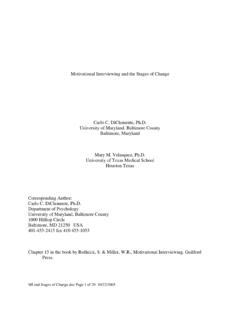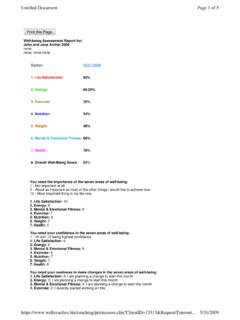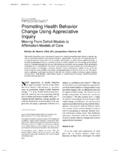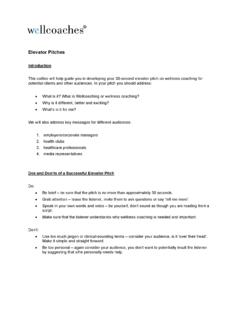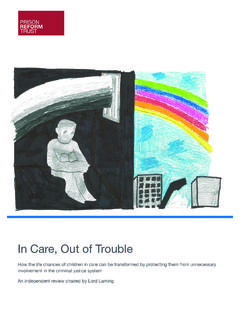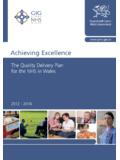Transcription of Appreciative Inquiry is not about the positive - …
1 Appreciative Inquiry Is Not about The positive Gervase R. Bushe, Segal Graduate School of Business Simon Fraser University February 2007 The thing that concerns me most about the current excitement and interest in Appreciative Inquiry (AI) is that many of the consultants and managers I talk to who claim to be doing AI don t seem to really understand it. Even some of my clients, after years of doing it, still don t understand what I think is most fundamental about AI. They all seem to get blinded by the positive stuff . After years of focusing on problems and deficits and dysfunction they get entranced with focusing on the positive and equate this with AI. But that s not the core of Appreciative Inquiry .
2 AI is about the generative, not the positive (Cooperrider & Srivastva, 1987). Maybe we should start calling it Generative Inquiry . Generativity occurs when people collectively discover or create new things that they can use to positively alter their collective future. AI is generative in a number of ways. It is the quest for new ideas, images, theories and models that liberate our collective aspirations, alter the social construction of reality and, in the process, make available decisions and actions that weren t available or didn t occur to us before. When successful, AI generates spontaneous, unsupervised, individual, group and organizational action toward a better future.
3 AI uses a focus on the positive to aid generativity. But discussion of the negative can, sometimes, handled certain ways, be generative too. Otherwise OD would not have a 50 year history and today be more relevant and influential than ever. There are many considerations, beside a focus on the positive , that go into crafting an effective Appreciative Inquiry . In this article I want to explore what is required for an Appreciative Inquiry to be generative and therefore, transformational - something quite different from action research with a positive question. First, I ll give an example of what I mean by transformational change and contrast that with another AI intervention that was a dismal failure, making the point that simply getting people to tell their best of stories may not accomplish much.
4 Then I ll look at what a focus on the positive does for AI by supporting generative thinking, supporting the change process, and making planned culture change possible. Next I ll describe some qualities that can make AI generative, looking at generative questions, generative conversations and generative actions. I ll conclude by pointing out that many of the same consulting issues and contingencies that effect traditional OD effect Appreciative Inquiry too. AI does not magically overcome poor sponsorship, poor communications, insensitive facilitation or un-addressed organizational politics. AI is an intervention into the social construction of reality. If successful, the organization s culture changes and stays changed.
5 For example, principals from one high school and four of its elementary feeder schools wanted to change the decade s old separation of elementary and high school teachers to better manage the learning experience of students. Few of either group had ever talked to each other. They even belonged to their own, separate unions. The five principals, in conjunction with a district wide AI initiative, launched an Inquiry into creating confident math learners focusing on the transition experience from elementary to high school. They collected stories of peak learning experiences from all stakeholders, engaged teachers, students and a few parents as interviewers and interviewees, and used my synergenesis method (described below) to create AI is not about the positive 2a Discovery Document combinations of stories and answers to their key questions, widely distributed.
6 Close to one hundred members of those schools attended a two day AI Summit (Ludema, Whitney, Mohr & Griffen, 2003) that concentrated on the Dream and Design phases and they left the summit with a set of eight design statements (sometimes called provocative propositions) and individual, personal commitments to take action on 3X5 cards which they attached to a roadmap to the future . A year later at least 2 transformational changes could be identified. 1. Conversations amongst teachers in the high school showed a heightened awareness of the importance of relationships for learning (which had been identified in most people s stories) and a new focus on fostering student confidence, not just in math but in all classes.
7 This was transformational for a group known to say I teach subjects, not students and resulted in a number of innovations. For example, the high school began holding student forums every 6 or so weeks a large gathering where they would ask the students an Appreciative question and listen to and learn from the stories that emerged. 2. The boundary between elementary and high school teachers and administrators was fully breached. As I write this a year after the summit, principals continue to meet regularly to plan activities and coordinate change. Emails go back and forth between elementary and high school teachers. They attend joint professional development days.
8 Now this is the key part: in the past year almost every elementary staff member involved in the AI moved out of their school to other jobs and were replaced with people who were not involved in the AI. Yet the transformation of this boundary continues, obviously not just on the strength of new relationships forged at the summit but from a deeper change in the culture of these schools. So often traditional, action research type OD has no impact at this level. In action research we identify an issue, engage people in the organization in collecting information, analyzing it, making recommendations for change and implementing those. Even though it might aim for transformation (variously labelled cultural, or developmental or break though change) and might have been transformational in organizations a few decades ago, today the process of action research tends to leave the current organization culture intact.
9 When AI is used this way identify what you want more of, collect stories about it, substitute Dream for analysis and the Design results in recommendations for change, no matter how positive the focus of Inquiry , it is unlikely to yield results beyond the normal impact of action research (Bushe & Kassam, 2005). Sometimes it can even be quite flat . For example, about ten years ago I spent a day with a group of construction managers telling stories of their best experiences of leadership. It was one of worst days I ve ever run. In response to their first ever employee opinion survey some senior managers decided they needed to better train managers in leadership.
10 I spent one day with the head of HR and a C-suite member devising this attempt to identify a common leadership model. We planned to do Discovery, Dream and Design in one day, beginning by having them pair up to tell stories of the best leader they had ever seen. During the day I discovered that this session was part of an influence struggle among senior management factions. The CEO displayed a somewhat interested demeanour through the first two thirds of the day and less interest thereafter symbiotically influenced by and influencing the slowly declining energy as the day wore on. These men (and they were virtually all men) had never thought much about leadership and didn t have much in the way of personal stories of inspiring leadership.

